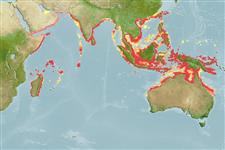分類 / Names
共通名の | 類義語 | Catalog of Fishes(部類, 種) | ITIS | CoL | WoRMS | Cloffa
板鰓亜鋼(サメとエイ類) (sharks and rays) >
Carcharhiniformes (Ground sharks) >
Carcharhinidae (Requiem sharks)
Etymology: Carcharhinus: karcharos (Gr.), sharp or jagged; rhinus, an ancient name for sharks, from rhine (Gr.), rasp, both words alluding to a shark's jagged, rasp-like skin (See ETYFish); amblyrhynchoides: -oides, Greek suffix meaning like, resembling, having the form of: similar to C. amblyrhynchos, to which it had previously been identified (See ETYFish).
More on author: Whitley.
Environment: milieu / climate zone / depth range / distribution range
生態学
海; 深さの範囲 0 - 75 m (Ref. 106604). Tropical; 26°N - 25°S, 43°E - 155°E
Indo-Pacific: Gulf of Aden and southwestern India east to Papua New Guinea, north to Taiwan and south to Australia.
Length at first maturity / サイズ / 重さ / 年齢
Maturity: Lm 115.0 range ? - ? cm
Max length : 182 cm TL オス/雌雄の選別がない; (Ref. 106604); 167.0 cm TL (female)
背面の脊椎 (合計) : 0; 肛門の骨: 0. Grey or grey-brown on dorsal surface, white or cream below, with a conspicuous band of white on sides from pelvic fins to first dorsal fin; pectoral, dorsal and pelvic fins, and ventral lobe of caudal fin black or dusky-tipped, sometimes inconspicuously (Ref. 9997).
A little-known inshore, coastal pelagic species (Ref. 9997). Feeds mainly on fishes, also takes crustaceans and cephalopods (Ref. 6871). Viviparous (Ref. 50449). Probably taken in fisheries where it occurs (Ref. 9997). Utilized fresh and dried salted for human consumption; fins used in the oriental shark fin trade; liver oil processed for vitamins (Ref. 9997).
Life cycle and mating behavior
成熟 | 繁殖 | 放精 | 卵 | 生産力 | 幼生
Viviparous, placental (Ref. 50449). 3 in a litter (Ref. 6871); 2-8 pups per litter (Ref.58048). Gestation period of 9-10 months (Ref. 6871). Size at birth 52 to 55 cm TL (Ref. 9997). Distinct pairing with embrace (Ref. 205).
Compagno, L.J.V., 1984. FAO Species Catalogue. Vol. 4. Sharks of the world. An annotated and illustrated catalogue of shark species known to date. Part 2 - Carcharhiniformes. FAO Fish. Synop. 125(4/2):251-655. Rome: FAO. (Ref. 244)
IUCNのレッドリストの状況は (Ref. 130435: Version 2024-1)
人間に対する脅威
Traumatogenic (Ref. 4690)
Human uses
水産業: 少数商業の
用具
特記事項
XMLをダウンロードして下さい
インターネットの情報源
Estimates based on models
Preferred temperature (Ref.
123201): 24.9 - 29, mean 28 °C (based on 974 cells).
Phylogenetic diversity index (Ref.
82804): PD
50 = 0.5000 [Uniqueness, from 0.5 = low to 2.0 = high].
Bayesian length-weight: a=0.00513 (0.00236 - 0.01115), b=3.08 (2.91 - 3.25), in cm total length, based on LWR estimates for this Genus-body shape (Ref.
93245).
栄養段階 (Ref.
69278): 4.2 ±0.6 se; based on diet studies.
回復力 (Ref.
120179): 非常に低い, 14年以上の倍増期間の最小個体群 (Fec=3).
Fishing Vulnerability (Ref.
59153): Very high vulnerability (90 of 100).
Nutrients (Ref.
124155): Calcium = 24.2 [4.2, 126.5] mg/100g; Iron = 0.89 [0.23, 2.63] mg/100g; Protein = 21.6 [18.9, 24.0] %; Omega3 = 0.175 [0.070, 0.449] g/100g; Selenium = 33.3 [7.9, 100.4] μg/100g; VitaminA = 18 [6, 52] μg/100g; Zinc = 0.672 [0.310, 1.285] mg/100g (wet weight);
